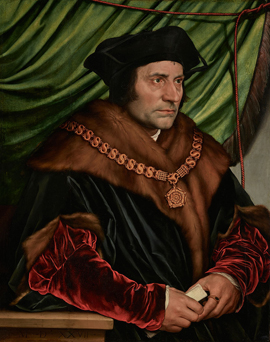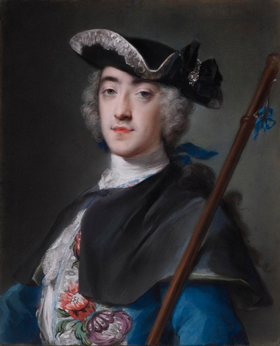Late to the Party
John Haberin New York City
Tudor England, Rosalba Carriera, and Nicolas Party
For me, the English Renaissance will always be the age of Shakespeare—and its history can only be as William Shakespeare wrote it. "Tudor England" has a taste for that history, fancy dress, and pageantry, at the Met. It just may not have much to do with Shakespeare, art, history, or England.
England all but missed out on the actual Renaissance. It was too busy coming off first the descent of Richard II into depression or madness, the seizure of his throne by Henry IV, and then a glorious but futile and rapacious invasion of France. Were that Hundred Years War not enough, it then busied itself with a long civil war and the War of the Roses. Shakespeare (picking up on Christopher Marlowe) invented the history play to tell its story. For him, the victory of Henry VII in 1457 put an end to the killing and scheming and ushered in a dynasty, the Tudors. Well, he could always hope. 
English art may not have had much of a Renaissance, apart from music and literature, but the Tudors could buy one. And the show is all about what money can buy. Had enough pomposity and history after that? Not Rosalba Carriera and Nicolas Party. The man I knew only as a pilgrim has abandoned his pilgrimage. His portraitist, Carriera, could have seen it coming—but not his place with Party at the Frick Madison.
Late to the party
If you have read Hilary Mantel, you know that the Tudor reign was hardly principled or lasting. You know that Henry VIII went through six wives and executed his most trusted advisors on the way to solidifying power and the Protestant Reformation. You know that the Tudors burned through five monarchs in a little more than a bloody century, finally achieving relative peace and prosperity under Elizabeth I. And then the dynasty was gone, and in no time revolution and repression resumed. But surprise, the Met is peddling Shakespeare's triumphant account as its own—and as the story of a privileged circle. His own grasp of life, from a ruler's private agony and exile to England's taverns and bedrooms, has no part.
Subtitled "Art and Majesty in Renaissance England," the exhibition cares far more for majesty than art. Its second section, "Splendor" could apply to the whole. Henry VIII, the Met swears, was frugal by nature, but he was, as the first section has it, "Inventing a Dynasty"—and that took the trappings of power. It took tapestries, medals, illuminated manuscripts, a French table, and Chinese porcelain. It took armor no longer shining, and everything was larger than life. A candelabrum by Benedetto da Rovezzano is a good twice human size, and his angels as candle holders are impressive, too, in their High Renaissance quarter turn.
Sections for "Languages of Ornament" and "Allegories and Icons" bow to the postmodern habit of seeing language everywhere, but allegories were the norm then as well, as was decoration. They were also courtly allegories and courtly decoration. A huge tapestry on the Biblical theme of creation and fall looks more like a garden party for the aristocracy. Another depicts the story of David and Bathsheba, and Henry knew a king's claim to women and property when he saw it. He is newly timely at that. Museums value fashion and displays of wealth as crowd pleasers, and the curators, Elizabeth Cleland and Adam Eaker, supply more of the same.
Henry was willing to sacrifice quality, too, assuming he knew the difference. Hans Holbein does his level best to deal with a king's emblems and to penetrate his knowing smile, but you are more likely to remember a second portrait, from Holbein's workshop, for the king's arms akimbo and his stride. Elizabeth may have fostered Shakespeare, but she has her priorities, too. One portrait in red and gold has uncertain attribution, as does the sole surviving portrait of Henry VII. She also turned to Quentin Massys for a more cryptic portrait—in which a sieve stands for the queen's virginity and a crowd stands apart. Regardless, Flemish dealers and Italian bankers were happy to deliver the goods.
Those looking for England's place in the Northern Renaissance will not be completely disappointed. It adopted Holbein as artist to the court, and he delivered most when he looked past royalty. The Frick lends its portrait of Sir Thomas More, with its vision of power, intelligence, and sheer color—with Robert Cheseman, Henry's favorite hunting companion, as the next best thing. Holbein sketched two of Henry's queens as well, looking almost as sad as their fates. He got into decorative art, too, in incredible detail, with designs for cups, plates, and a fireplace. Like Shakespeare, he was above nothing.
England's own leading artist, Nicholas Hilliard, has a full wall for portraits. Known for his miniatures, he worked in watercolor and thrived on personality. A portrait of Henry's son, Edward VI, who reigned ever so briefly and died at age fifteen, is poignant as well in a portrait by no one in particular. He holds a Tudor rose up to a scraggly plant, a darkening sky, and a distant star. The show's heart lies elsewhere, in the embrace of power, but then William Shakespeare transferred his loyalty after Elizabeth's death to James, the first Stuart—as well he should, for his company became the king's players. "You had a maid who did nothing but dress you," a visitor was saying as I left, and you can only hope that this is about you.
The company he keeps
Rosalba Carriera entered the Frick Collection just this past year, with the Gregory gift, and her Man in Pilgrim's Costume leaves a dark gray spot on the wall. Its companion, a female portrait, remains behind through the midsummer end of the gift's display. So, too, does their shared spirit of Rococo excess. He might have claimed his luxurious surroundings, amid the decorative arts, as his own. He could also have scorned them, with pleasure, as impious and inferior—or was that just a pose? Scholars speculate that his costume merely alludes to his family name.
Perhaps, but art has a long tradition of titled wealth putting on airs of piety and humility. How better for the Tudor court in England to show its place among kings? How better for Pietro Aretino at the Frick, the author of lives of saints along with satires, to display his dignity. knighthood, and erudition, in a portrait by Titian. As I wrote about the gift, the man wields his pilgrim's staff like a weapon. His identity remains unknown, but then Carriera could not pull off psychology or particulars. No wonder she appealed to collectors of ceramics, gilding, and privilege.
Is the pretend pilgrim also just plain silly? Nicolas Party embraces silliness. His is the second pairing of historic work from the collection with contemporary art. The series began after the move to the former Whitney Museum and Met Breuer on Madison Avenue while the Frick mansion is closed for renovation.  Dubious about the shift in great museums like the Met, the Morgan Library, and now the Frick to indulge in contemporary art? Party could well be satirizing it. He can also do a pretty good imitation of the old masters, give or take bright purple.
Dubious about the shift in great museums like the Met, the Morgan Library, and now the Frick to indulge in contemporary art? Party could well be satirizing it. He can also do a pretty good imitation of the old masters, give or take bright purple.
Carriera gives pastels the richness of portraits in oil, and Party does her one better. Born in Switzerland in 1980, he uses an alcove in a room for Renaissance portraits to give her portrait both its forebears and a place to itself. It hangs between facing waist-up portraits in the same high style. One has white hair, in accord with eighteenth-century fashion but as bushy as an afro. The other has black hair but flecked with white, to match the white spots of its outrageous clothing. The one with white hair is young and white, the one with black hair, sure enough, a bright purple.
They also have red lips and uncertain gender, like so much art today. (Your guess is as good as mine.) Their fancy dress approaches the decorative arts after all, but not nearly as much as the walls behind them. Party's pastels extend to them. They blow up Carriera's fluid touch to wallpaper. They also carry her realism to the illusion of fabric.
The wall behind her painting pictures folds upon folds of fabric, leaving the underlying folds and fringes in shadow. The one behind the purple person billows out, while the one behind the white person blurs away. Oh, and the latter wears a purple shirt and red tie to match its companion's purple face and red-flecked top. Does all this pretence and patterning upstage a mere pilgrim? Maybe he would have said that he deserves the company. Or maybe he would have said that it shows his superiority and his piety.

"Tudor England" ran at The Metropolitan Museum of Art through January 8, 2023, Rosalba Carriera and Nicolas Party at The Frick Madison through March 3, 2024.




